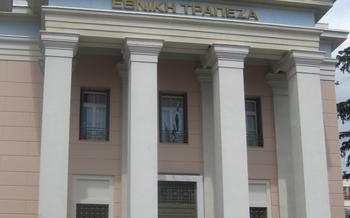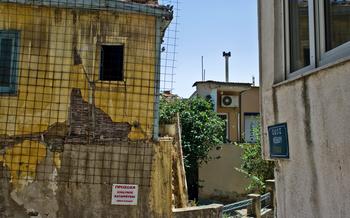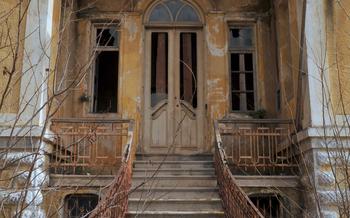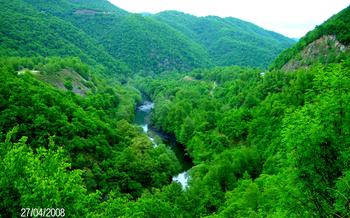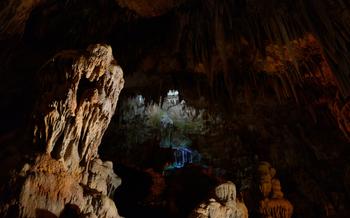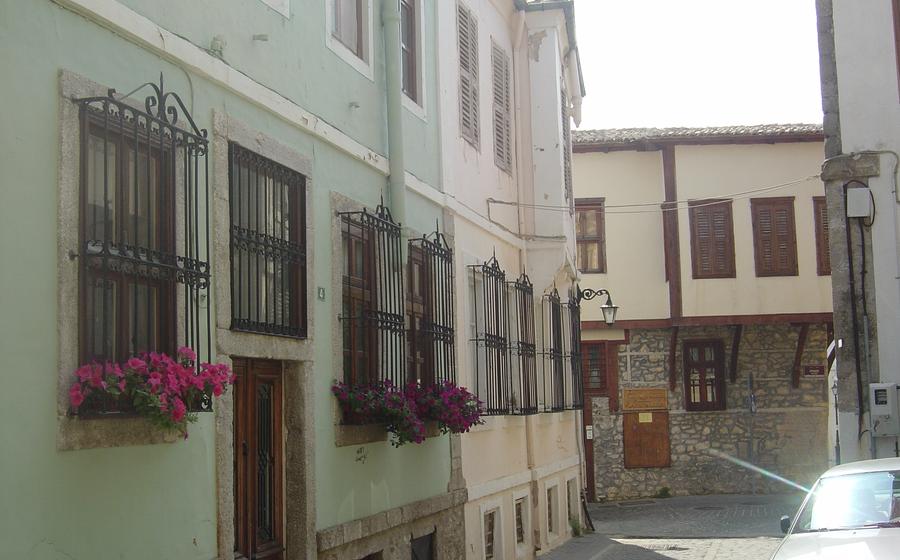
The Natural History Museum of Stavroupoli
- History of the Museum:
- Museum's Collection:
- Educational Value
- Exhibits and Displays
- Focus on Local Biodiversity:
- Hands-On Experiences
- Temporary Exhibitions
- Guided Tours
- Research and Conservation Efforts
- Accessibility and Facilities:
- Location and Getting There
- Visitor Information and Contact Details
- Tips for Visitors
- Nearby Attractions
- Insider's Tip: Hidden Gems and Photo Opportunities
History of the Museum:
The Natural History Museum of Stavroupoli was established in 1994, born from the love and dedication of a group of naturalists and enthusiasts who wanted to preserve and celebrate the rich natural heritage of Xanthi. Their efforts were supported by the local community, and after years of hard work, the museum opened its doors to the public, offering a comprehensive journey through the natural world, from the smallest insects to the largest mammals. Today, it stands as a testament to their passion and continues to inspire and educate visitors of all ages.
The history of natural history in Xanthi can be traced back to the late 19th century when the region was known for its diverse flora and fauna. Local scientists and naturalists were intrigued by the variety of plant and animal species found in the area, and they began collecting and studying them. Their contributions laid the foundation for the development of the museum, which has since become a valuable resource for research and education.
Museum's Collection:
The museum's collection is vast and varied, boasting an array of exhibits and specimens that showcase the wonders of natural history in Xanthi. Visitors can delve into the fascinating world of geology through a comprehensive display of rocks and minerals, ranging from sparkling crystals to fossils that tell tales of ancient life. The botanical section features an extensive herbarium, showcasing the region's diverse flora with meticulously preserved specimens. The zoological collection is a treasure trove of animal life, with mounted displays of birds, mammals, reptiles, and amphibians that bring the natural world to life. A highlight of the collection is the prehistoric skeleton of a mastodon, which towers over visitors with its impressive size. The museum also houses a unique collection of marine life, featuring preserved specimens from the Aegean Sea, offering a glimpse into the rich underwater world of the region.
Educational Value
The Natural History Museum of Stavroupoli is not merely a repository of specimens; it is also a vibrant hub for environmental education and outreach. Embracing the vital role it plays in fostering environmental awareness, the museum has developed an array of educational programs tailored to visitors of all ages. School groups and families are welcomed to embark on guided tours led by knowledgeable staff, who bring the exhibits to life with engaging stories and interactive activities. These tours are designed to ignite curiosity and cultivate a deeper appreciation for the natural world.
In addition to guided tours, the museum offers a range of educational workshops and lectures throughout the year. These programs delve into specific topics related to natural history, conservation, and environmental science. By providing a platform for experts to share their knowledge, the museum encourages critical thinking and empowers visitors to become informed advocates for the environment.
The museum's commitment to education extends beyond its walls, reaching into the community through outreach programs. Staff members regularly visit local schools to conduct interactive presentations and lead nature walks, fostering a love for nature among young minds. Through these initiatives, the museum strives to inspire the next generation of environmental stewards and contribute to a more sustainable future.
Exhibits and Displays
The Natural History Museum of Stavroupoli offers a diverse range of exhibits and displays that bring the wonders of the natural world to life. Interactive exhibits and multimedia presentations engage visitors, allowing them to explore and learn about different ecosystems and species. Dioramas and life-size models showcase various habitats, from lush forests to vibrant coral reefs, providing a captivating glimpse into the intricate tapestry of life on Earth. Through these immersive displays, the museum aims to foster a deeper understanding and appreciation for the beauty and complexity of our planet's ecosystems.
Focus on Local Biodiversity:
The museum dedicates significant attention to the rich biodiversity of the Xanthi region. It showcases numerous species, both plant and animal, that are native to the area and holds special focus on preserving and understanding their delicate ecosystems. Visitors can explore exhibits highlighting unique species such as the Xanthi lyrebird, a critically endangered bird found only in this region, and the Rhodope Mountains toad, renowned for its vibrant coloration and unique mating calls. These exhibits not only educate and inform but also raise awareness of the importance of conservation and the need to protect these unique species and their habitats.
Hands-On Experiences
The Natural History Museum of Stavroupoli offers visitors a variety of interactive exhibits and hands-on experiences that make learning about natural history both fun and engaging. Visitors can touch and feel real animal specimens, get up close with life-size models, and explore the natural world through microscopes and other sensory displays. These interactive exhibits provide a unique and unforgettable experience for visitors of all ages, allowing them to connect with the natural world in a hands-on, experiential way.
One of the highlights of the museum's interactive exhibits is the touch tank, where visitors can safely interact with live aquatic creatures such as starfish, sea urchins, and anemones. This hands-on experience allows visitors to learn about the unique adaptations and behaviors of these marine animals and to appreciate the diversity of life in the ocean. Another popular exhibit is the "Build-a-Habitat" station, where visitors can create their own miniature ecosystems using a variety of natural materials. This activity encourages creativity and critical thinking while teaching visitors about the importance of biodiversity and the interconnectedness of living organisms.
Temporary Exhibitions
The Natural History Museum of Stavroupoli is not confined to its permanent collection. It also hosts a variety of rotating exhibitions on specific themes or topics, showcasing the latest scientific discoveries and conservation efforts. These temporary exhibitions are often curated in collaboration with other institutions and organizations, bringing a diverse range of perspectives and expertise to the museum.
Past exhibitions have explored topics such as the evolution of life on Earth, the diversity of ecosystems, and the impact of climate change on biodiversity. Through these exhibitions, the museum aims to engage visitors with cutting-edge research and contemporary issues, fostering a deeper understanding of the natural world and inspiring action for its preservation.
Guided Tours
The Natural History Museum of Stavroupoli offers guided tours for groups and individuals, providing visitors with an immersive and educational experience. Knowledgeable staff members lead these tours, sharing insights into the museum's exhibits, the local biodiversity, and the history of natural history in Xanthi. Guided tours are an excellent way to delve deeper into the museum's collection and gain a comprehensive understanding of the natural world. Visitors can book guided tours in advance or inquire at the museum's information desk upon arrival. The museum's staff is always happy to assist visitors and provide additional information to enhance their experience.
Research and Conservation Efforts
The Natural History Museum of Stavroupoli is actively involved in scientific research and conservation projects, contributing to the preservation and understanding of the region's biodiversity. The museum collaborates with universities, research institutions, and conservation organizations to conduct studies on various aspects of natural history, including species identification, habitat assessment, and ecological interactions.
The museum's research efforts focus on understanding the unique ecosystems and species found in the Xanthi region. Scientists and researchers utilize the museum's extensive collection and resources to conduct field studies, analyze specimens, and contribute to the body of knowledge in natural history.
In addition to research, the museum plays a crucial role in conservation initiatives. It actively participates in conservation projects aimed at protecting endangered species and their habitats. The museum's staff collaborates with local communities, government agencies, and environmental organizations to implement conservation strategies, raise awareness, and promote sustainable practices.
Through its research and conservation efforts, the Natural History Museum of Stavroupoli contributes to the preservation of the region's rich biodiversity and promotes a deeper understanding of the natural world.
Accessibility and Facilities:
The museum is committed to providing an inclusive and accessible environment for all visitors. Wheelchair ramps and elevators ensure that every exhibit is accessible to those with limited mobility. Visitors with visual impairments can request audio guides, while tactile exhibits and braille signage enhance the experience for those with visual impairments. The museum also offers a range of amenities to ensure a comfortable visit, including a gift shop where visitors can find unique souvenirs and educational resources, a cozy cafe serving refreshments, and clean and well-maintained restrooms.
Location and Getting There
The Natural History Museum of Stavroupoli is conveniently located in the heart of Stavroupoli, a vibrant town in the Xanthi region of Greece. The exact address of the museum is 10, 28th October Street, Stavroupoli 671 00, Greece. To get there, visitors can take advantage of the reliable public transportation system. The Stavroupoli bus stop is just a short walk away from the museum, providing direct connections to various parts of the city. Additionally, ample parking space is available in the vicinity, ensuring a hassle-free visit for those arriving by car.
Visitor Information and Contact Details
The Natural History Museum of Stavroupoli is open to the public from Tuesday to Sunday, with varying hours depending on the season. Admission fees are minimal, and there are discounts for students, seniors, and families. The museum's website provides detailed information on operating hours, admission fees, and any special events or exhibitions.
For further inquiries or to book a guided tour, visitors can contact the museum directly by phone or email. The knowledgeable and friendly staff is always ready to assist with any questions or requests. Their expertise and passion for natural history make them invaluable resources for anyone seeking a deeper understanding of the museum's exhibits and the natural world they represent.
Tips for Visitors
To make the most of your visit to the Natural History Museum of Stavroupoli, here are a few insider tips:
- Avoid visiting during the peak tourist season (July and August) to avoid crowds.
- Wear comfortable shoes as you'll be doing a lot of walking and exploring.
- Be mindful of the museum's etiquette and maintain a respectful silence while observing the exhibits.
- Take your time and don't rush through the exhibits. Each display has something unique to offer, so savor the experience.
- Take advantage of the interactive exhibits and hands-on experiences to engage with the museum's collection in a memorable way.
- Don't forget to visit the gift shop for souvenirs and educational materials related to the museum's exhibits.
- If you have any questions or need assistance, don't hesitate to approach the friendly and knowledgeable museum staff.
Nearby Attractions
After exploring the wonders of the Natural History Museum of Stavroupoli, visitors can embark on a journey through Xanthi's rich history and cultural tapestry. Just a short stroll from the museum, travelers will find themselves immersed in the vibrant heart of the city.
Xanthi's Old Town beckons with its charming cobblestone streets, traditional architecture, and colorful shops. History buffs can delve into the past at the Folklore Museum, which houses a collection of artifacts showcasing the region's customs and traditions.
For those seeking a taste of Xanthi's culinary delights, the Central Market offers an array of fresh local produce, spices, and delicacies. Visitors can savor the flavors of traditional Greek cuisine at the many tavernas and restaurants that line the market's lively streets.
Art enthusiasts will find solace in the Municipal Art Gallery, which exhibits a diverse collection of contemporary and classical artworks by local and international artists.
Nature lovers can escape the urban hustle and bustle at the Nestos River Delta National Park, a haven for biodiversity with lush forests, tranquil wetlands, and a rich birdlife.
To make the most of your visit to Xanthi, consider crafting a mini-itinerary that allows you to experience the city's diverse offerings. Start the day with an exploration of the Natural History Museum, then delve into the depths of Xanthi's history and culture at the Folklore Museum and Old Town. Afterward, tantalize your taste buds with a culinary adventure at the Central Market. Conclude your day with a peaceful retreat at the Nestos River Delta National Park, where you can immerse yourself in the beauty of nature.
Insider's Tip: Hidden Gems and Photo Opportunities
As you explore the wonders of the Natural History Museum of Stavroupoli, keep an eye out for these hidden gems:
-
Secret Garden: Step outside the museum's main entrance and discover a serene secret garden filled with native plants and flowers. It's a peaceful spot to relax and soak in the beauty of nature.
-
Diorama Viewing Platform: Head to the upper level of the museum and find the viewing platform overlooking the diorama exhibits. This unique perspective offers a bird's-eye view of the recreated ecosystems and allows you to appreciate the intricate details from a different angle.
-
Touch and Feel Display: In the interactive zone, seek out the touch-and-feel display where you can get up close and personal with various animal pelts, bones, and other natural materials. It's a great opportunity to engage your senses and learn about the textures and characteristics of different species.
-
Microscope Corner: Don't miss the microscope corner, where you can examine tiny specimens and marvel at the intricate details of the natural world that are often invisible to the naked eye. It's a fascinating way to discover the hidden wonders of the microscopic realm.
-
Hidden Photo Spot: For a truly unique photo opportunity, head to the museum's rooftop terrace. From here, you can capture stunning panoramic views of the surrounding landscape, with the museum's distinctive architecture in the foreground. It's the perfect spot for a memorable shot.
